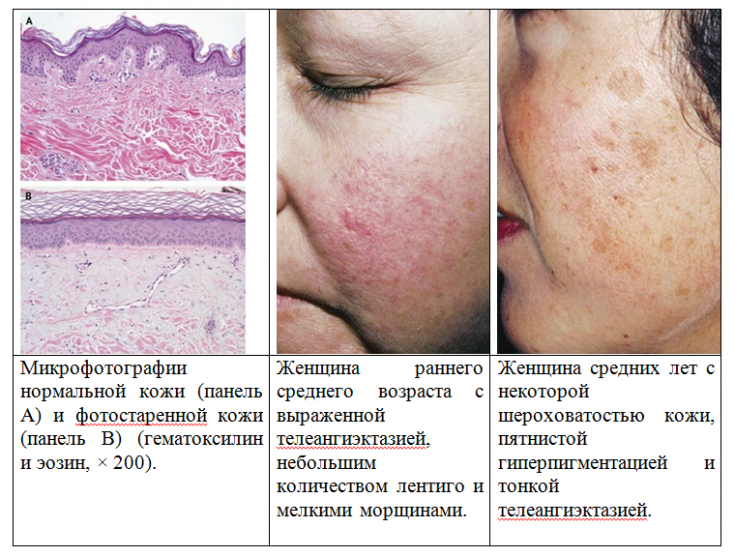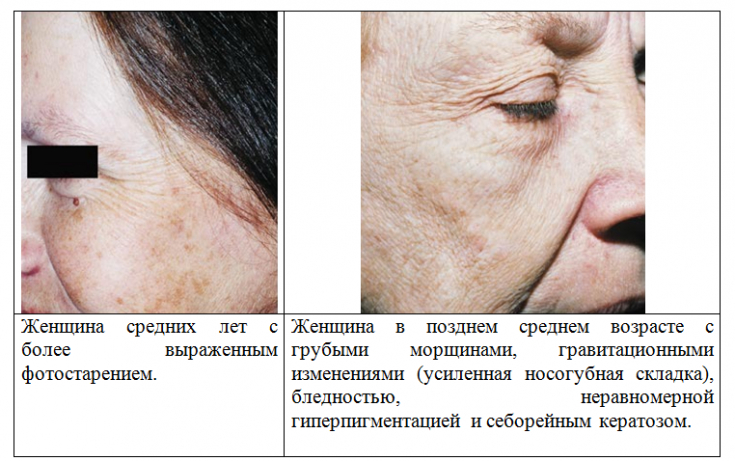Aging and environmental influences affect the appearance of the face. Age-related changes include benign growths and "gravity" that results from the redistribution of fat, reduced skin elasticity, and bone loss. Sun exposure causes clinical and histological skin changes commonly referred to as photoaging.
Clinically, photoaging can manifest as wrinkles, roughness and dryness of the skin, pigmentation, telangiectasia, pallor, and the appearance of brown lentigo spots. Other common aging skin changes include seborrheic, actinic keratosis, which are sun-induced, precancerous, aesthetically unpleasing, and sometimes symptomatic.
In the article estet-portal.com you can learn more about the clinical features of photoaging.
Photoaging and skin cancer risk
Wrinkles and telangiectasia are associated with an increased risk of actinic keratosis and skin cancer (age-adjusted odds ratio, 2 to 9).
The presence of actinic keratosis is strongly associated with an increased risk of developing squamous cell carcinoma.
Therefore, individuals with significant photoaging should be periodically screened for actinic keratosis and skin cancer.
Cumulative exposure to sunlight and exposure over the past 10 years is strongly associated with the risk of actinic keratosis and hence squamous cell carcinoma in people of all ages. They are also likely related to the degree of photoaging.
Risk factors for photoaging and skin cancer include fair skin, sunburn, and advanced age.
Smoking is a moderate independent risk factor for wrinkles, telangiectasias, and squamous cell carcinoma.
Ultraviolet B (UVB) radiation (wavelength 290 to 320 nm) is much more important for the induction of non-melanoma skin cancer and actinic keratoses than ultraviolet A (UVA) radiation (320-400 nm).
Follow us on Telegram
Generalized photoaging management recommendations
Signs of photoaging, including yellowing, roughness, fine lines and speckled hyperpigmentation, are reduced with photoprotection. Daily use of sunscreen (SPF 15 or higher) should generally be recommended, which slows down, slightly reduces photoaging and reduces the incidence of actinic keratoses and squamous cell carcinoma.
Both artificial and natural tanning is not acceptable.
HEV radiation: unique technologies
Given the well-recognized associations between benign manifestations of photoaging (such as fine lines and telangiectasias) and potentially severe skin lesions, patients with significant photoaging should be evaluated for actinic keratosis and skin cancer that require treatment.
For a limited number of actinic keratoses, cryosurgery should be used. If there are many actinic keratoses, a topical fluorouracil cream should be preferred, used daily for 2-3 weeks — a regimen that reduces the number of actinic keratoses and improves skin texture.

If standard therapies are not suitable, photodynamic therapy and imiquimod may be appropriate.

For patients who want to "treat photoaging", retinoids are the most effective topical therapy.
Preparations containing hydroxy acids also have a small positive effect on roughness, yellowness and discoloration. Don't underestimate the benefits of emollients and makeup to smooth and mask these changes.
Many beauty products also contain sunscreen.
Most of the changes that occur as a result of photoaging have similar causes and risk factors, but the extent and consequences of these changes vary greatly among patients. The decision whether to provide treatment depends on the nature of the changes, their severity, the extent to which they disturb the patient, and the patient's willingness to accept the risks and costs of treatment.
Thank you for staying with estet-portal.com. Read other interesting articles in the "Cosmetology" section. You may be interested in Photoaging is reversible: ways to prevent







Add a comment